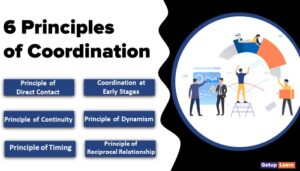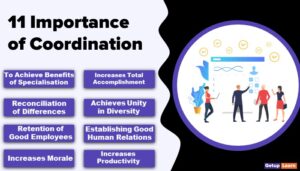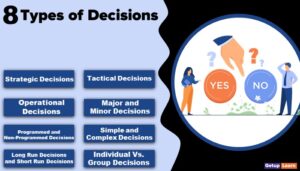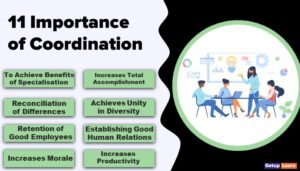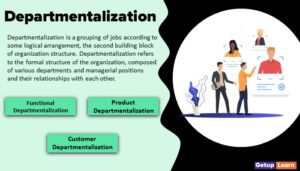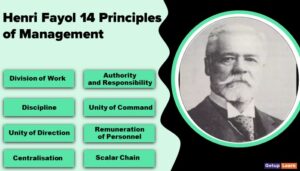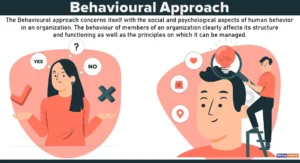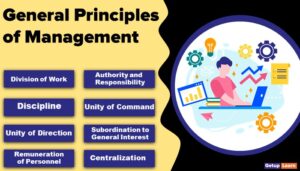Table of Contents
Meaning of Project Management
Project management ensures that a project is planned and managed right from start to finish so that it delivers the expected outcomes within the planned time, cost, and quality.
Project management is not just about forming a group of people, giving them assignments and deadlines, and expecting them to deliver. If that were the case, then 76% of people would not fail. Project management is the glue that binds all aspects of a successful project handling together, including cost, time, quality, project teams, stakeholders, and management.
Project Management Life Cycle
The life cycle of a project may differ from project to project; however, the management life cycle remains the same for all projects. Figure 1 shows the different phases of project management:

The five phases of the project management life cycle are explained as follows:
Analysis and Evaluation
It is the first and most complex phase that sets the foundation for a project. Table 1 lists the different analysis and evaluation activities performed in this phase:
| Analysis Activities | Evaluation Activities |
| Identify specification requirements to achieve project activities. | Evaluate production factors (cost, time, equipment, and material requirements. |
| Project feasibility study. | Evaluate marketing factors (potential market size and share) |
| Trade-off analysis to evaluate various alternatives to achieve project objectives. | Evaluate financial factors (required investment and profitability, etc.) |
| Evaluate administrative and miscellaneous factors (regulatory compliance, relationship with customers, suppliers, and competitors) |
Evaluate human resource factors (required training and skills, resistance from workforce, communication) |
| Evaluate human resource factors (required training and skills, resistance from the workforce, communication) |
Marketing
in this phase, the project manager along with the marketing team prepares a Marketing Requirement Document (MRD) that captures the customer’s requirements and sets the market context, such as the need for the project, targeted market, etc.
Design
In this phase, the requirements in the approved MRD are used to describe the design elements of the projects, which includes:
-
Functional Hierarchy Diagrams: Indicate the hierarchical relationship of all the required functions in the project.
-
Screen Layout Diagrams: Indicate the layout and features of elements.
-
Tables of Business Rules: Include the management guidelines.
-
Business Process Diagrams: Illustrate the workflow of business processes in a logical sequence.
- Pseudocode: Refers to the code for referring project team members (known only to them.)
- Entity relationship diagram (with a full data dictionary): Represents data groups and their relationships using a standard set of symbols. Some points to be taken care of while designing a project are:
- Design a simple and harmonious project for a common objective.
- Ensure proper and effective communication at all levels of the project.
- Design a closed system with a provision for external interactions.
- Design a simple and harmonious project for a common objective.
Inspection, Testing, and Delivery
In this phase, the project manager tests and tracks the project’s progress to ensure that the deliverables are up to specified standards. If not, then corrective measures are taken. This phase ensures the control of project schedule, cost, quality, functional scope, and risk.
Post-Completion Analysis
After the project deliverables are released and the project is closed, the project performance is evaluated with respect to the following questions:
- Did it achieve the stated objectives in the plan?
- Did it operate with the established scope?
- Did its deliverables meet the defined quality specifications?
- Were the deliverables released within the planned schedule and budget?
The above feedback is recorded from customers, project team members, and other stakeholders. Its purpose is to document the lessons learned from the project for future use.
Roles and Responsibilities of Project Manager
Responsibility and accountability of a project rest on a project manager. The project manager is considered the anchor of a project and the one who has the overall responsibility for the project.
He/she is responsible for ensuring the project’s success, well-informed decisions, and making optimum use of resources to fulfill project objectives. Let us discuss the roles and responsibilities of the project manager in detail. A project manager assumes different roles as per the demands of the project. He/she may act as a:
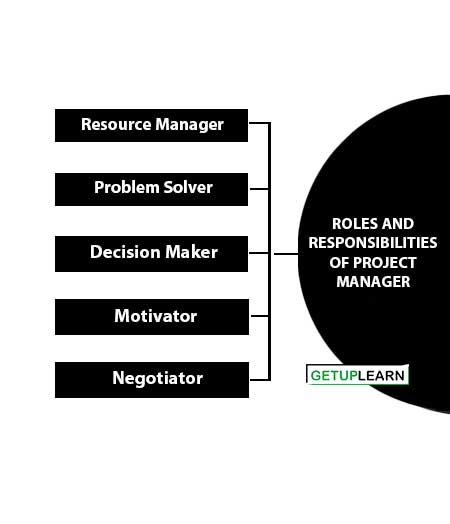
Resource Manager
A project manager is responsible for procuring resources to carry out activities required to complete a project. For example, a project manager overseeing a car manufacturing project would be responsible for procuring high-quality resources such as engines, seats, plastics, glasses, rubber, and copper to deliver high-quality output.
Problem Solver
A project manager should be capable of facing any project-related challenges irrespective of the size or scale of the project. He/she is responsible to deal with obstacles such as technical issues, accidents at the project site, unforeseen changes in the project plan, and increases in cost. The project manager is responsible for managing people associated with a project.
Different people have different personalities, traits, and attitudes, and bringing them in line with the project goal is an uphill task. The possibility of conflict among workers is also high.
A project manager should take preemptive measures and nip such conflicts in the bud. He/ she should take steps to develop a better understanding among team members. In addition, the project manager should encourage team members to focus on project goals rather than individual interests.
Decision Maker
A project manager is required to make several decisions related to the project, workforce, machine, raw materials, etc He/she needs to consider various factors such as cost and budget before making any decision. One wrong decision may lead an organization to shelve the project.
Motivator
Tight schedules and deadline-driven work put mounting pressure on workers, resulting in higher stress levels and dissatisfaction among workers. A project manager is responsible for keeping the team members motivated.
He/she should motivate his or her team members by acknowledging their performance, rewarding the best performers, and listening to their personal and professional concerns. This helps team members to perform efficiently.
Negotiator
A project manager is responsible for negotiating with various stakeholders such as clients, suppliers, and financers. He/she should also interact with customers to identify their needs, tastes, and preferences, and fulfill them.
The role involves managing the project team to deliver its best in order to achieve the project’s stated outcomes. The job of a project manager is not easy. Thus, it is important to appoint a competent person to handle a project. Some of the responsibilities of a project manager include:
- Identifying the needs and expectations of customers and charting a reasonable project plan to achieve them.
- Acquiring and managing the project resources.
- Maintaining proper communication and relations with various stakeholders, such as customers, suppliers, and financiers, for procurement of resources.
- Ensuring smooth project operations.
- Ensuring adherence to project costs and schedules and being accountable for them.
- Taking care of the project team members through rewards and recognition, listening to their concerns, and providing support for their optimum performance.
- Resolving the human resource issues within the project team and between the team and management.
Stages of Team Development of Project
A project team is a group of individuals with different skills and talents who come together to achieve a common goal. The project manager forms and directs the project team. There are five stages of team development of project team, as shown in Figure:

These five stages of project team development are explained as follows:
Forming
This stage occurs when the team members first meet each other. They share information about their backgrounds and interests, form first impressions of each other, learn about the project, and start thinking about their role within the team.
Role of the project manager in this phase:
- To clarify the team’s goals and provide direction about the project.
- To determine the team’s roles and responsibilities.
- To establish team norms.
Storming
This stage is unavoidable when the team begins to work together. The team members compete with each other for status and acceptance of their ideas. Their strong viewpoints may lead to conflicts. The project manager should act to resolve them as early as possible.
As this phase ends, the members start settling into their roles in the team and become more accepting of each other. Role of the project manager in this phase:
- To encourage active listening and being open to other’s viewpoints.
- To facilitate equal participation from all team members.
- To coach team members on being assertive or being more open.
- To resolve conflicts as quickly as possible.
- To start transitioning some decisions to teams to encourage independence
Norming
Teams that graduate to this phase begin to work better as a team. They are focused on accomplishing project goals. They respect each other’s viewpoints and value their differences. At this stage, the team members trust each other and seek assistance and input from each other. As a result, project performance Improves.
Role of the project manager in this phase:
- To give more responsibility to the team in decision-making and problem-solving and step in when things get stuck.
- To coach the team on how to work more collaboratively.
Performing
In this stage, the project team performs at its peak. This is a rare phase, which only some teams manage to reach. Role of the project manager in this phase:
- To not get involved in decision-making, problem-solving, or other day-to-day activities of the project team.
- To track the project progress and celebrate milestone achievements with the team to foster team spirit.
Adjourning
This is the last stage when the project comes to a close and team members move on to different projects. This phase focuses on the well-being of the team members as they say goodbye to each other. Role of the project manager in this phase:
- To celebrate the success of the project with the team.
- To document lessons learned for future use.
Problems of a Project Team
Project managers must identify the problems that are preventing their teams from delivering together as a group, and then resolve them. There are three main problems for project teams:
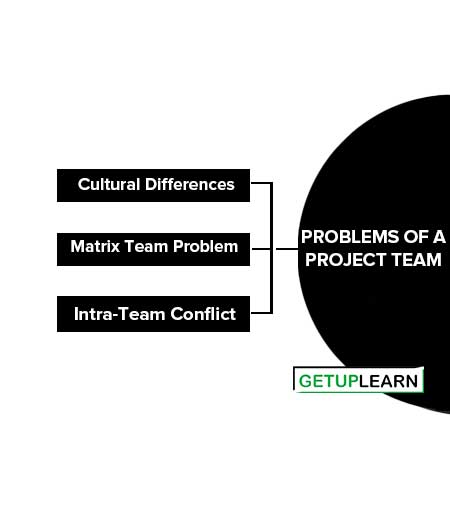
Cultural Differences
Cultural differences among project teams often impede project progress as members are not familiar with each other’s code of conduct or cultural sensitivity. For example, a person from the US would need to be very sensitive to Middle Eastern culture.
Thus, the project manager should allocate time and resources for the team to physically meet each other, and at least begin the project with a formal kick-off meeting. They should encourage teams to respect and celebrate their cultural differences. They should build a safe climate to develop trust within the teams.
Matrix Team Problem
A matrix team is one where a team member has at least two managers: a functional manager and a project manager. This type of team structure results in interpersonal conflicts as the team member’s loyalties may be tom between two viewpoints.
The decision-making takes longer as the team member has to report to multiple parties and wait for a consensus. Also, different forms of communication can be interpreted differently, leading to confusion, delays, and lost productivity.
Intra-Team Conflict
Conflicts between members of the project team are natural. If unresolved, this will result in miscommunication, lost productivity, a stressful work environment, and even employee resignations. However, if handled correctly, these conflicts can release communication and a renewed sense of teamwork.
Some ways to handle intra-team conflicts are:
-
Conflicts due to misunderstanding over goals and deadlines: Clarify goals, outline strategies to them, prioritize strategies, make assignments, and set deadlines.
-
Conflicts due to clash of personalities: Bring the conflict out in the open. Set expectations regarding communication and conflict resolution. Intervene, if conflicts are not resolved mutually.
- Conflicts due to implementation style: Conduct mediation training to teach the value of active listening, negotiation, and compromise.
Project Management Challenges
Only 2.5% of organizations are able to successfully finish their projects on time. Viniy is it that these companies have succeeded when so many others struggle? It is because these companies not only plan and manage resources and time appropriately, but they also anticipate the issues that may restrict the project’s progress.
Some project management challenges and the appropriate methods to resolve them are given below:
- Unclear Goals
- Unworkable Deadlines
- Scope Creep
- Lack of Adequate Skills
- Improper Communication
- Remotely Located Teams
- Risk Management
- Team Conflicts
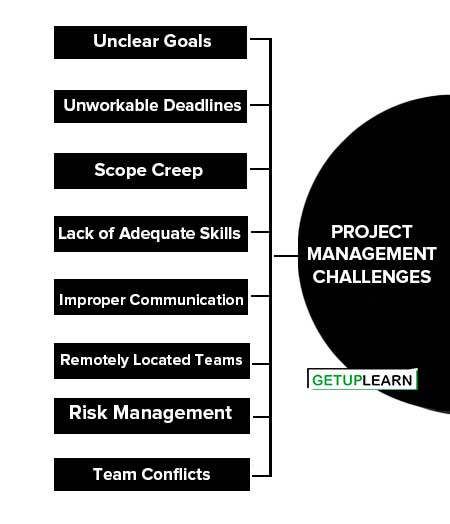
Unclear Goals
Hold a kickoff meeting to define clear goals.
Unworkable Deadlines
Create a reasonable schedule, stick to it, and remember important dates.
Scope Creep
This happens when a project goes beyond the planned objectives. To avoid it, determine project goals (cost, schedule, quality) adequately on the basis of customer needs. Develop realistic assumptions about resource availability and deadlines. Document and communicate project progress to stakeholders, team, and management.
Lack of Adequate Skills
Document the core set of skills required for the project. Evaluate the strengths and weaknesses of each team member and train them, if necessary.
Improper Communication
Develop proper communication channels and programs for intra- and inter-team communication.
Remotely Located Teams
Develop and manage collaboration programs.
Risk Management
Strategically collect and analyze information to identify, assess, and plan for potential risks.
Team Conflicts
Create a positive work environment. Include team-building activities to promote teamwork.
FAQs About the Project Management Life Cycle
What are the stages of project management life cycle?
These are the five stages of project management life cycle: 1. Analysis and Evaluation 2. Marketing 3. Design 4. Inspection, Testing, and Delivery 5. Post-Completion Analysis.
What are the responsibilities of project manager?
These are the responsibilities of project manager: Resource Manager, Problem Solver, Decision Maker, Motivator, and Negotiator.
What are the project management challenges?
These are the project management challenges: 1. Unclear Goals 2. Unworkable Deadlines 3. Scope Creep 4. Lack of Adequate Skills 5. Improper Communication 6. Remotely Located Teams 7. Risk Management 8. Team Conflicts.

